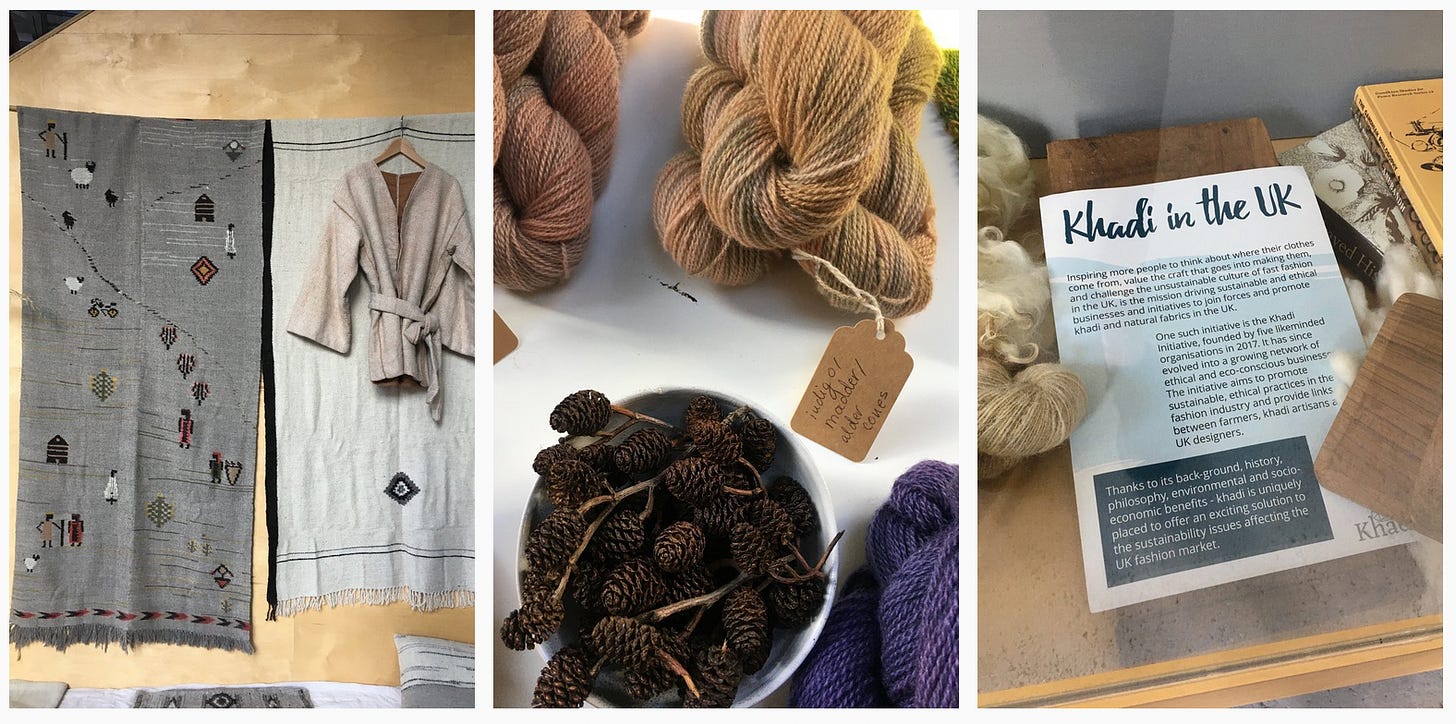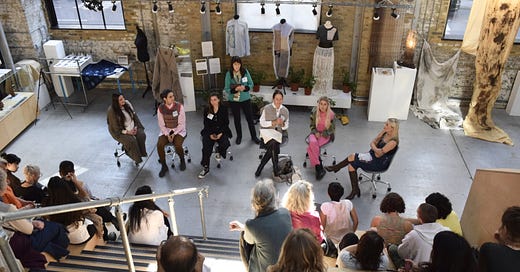The Festival of Natural Fibres 2022. Part 1.
What does growing natural fibres in a regenerative way look like, and how scalable is it? This post gives a reflection of the festival's panel discussion on this first part of the fibre value chain.
The Festival of Natural Fibres was hosted for the sixth year by Freeweaver Saori Studio and Khadi London at Craft Central in South East London in October 2022 over two days.
It’s aims were to create a welcoming space for all those enthusiastic, entranced, or simply curious about natural fibres and brought together a community of farmers, researchers, designers, makers, activists and entrepreneurs to demonstrate and discuss the emerging conversations and technologies in the space.
Each day of the festival focussed on a specific aspect of natural fibres; day one was regarding the value chain - the growing, processing, making and designing, and day two regarded the wider systemic issues, revolving mostly around regenerative economies.
For the purpose of such a lot of information, I’ve split the retelling into a few parts: part one is the growing part of the value chain, part two is the processing part of the value chain, including a tidbit on my attempt at charkha spinning, and a snippet from the making and designing panel, and then part three is on regenerative economies, which includes some reflection on Dylan Howitt’s film about Allan Brown’s work The Nettle Dress.
This is part one, looking at the growing aspect of the natural fibre value chain.
Subscribe to receive updates of the next parts ⇾
Growing.
Panel discussion with Sanne van den Dungen (regenerative cotton Raddis®), Amit Dalvi (Beejkatha and Khadi London), Claire O’Sullivan (Contemporary Hempery), Ellie Byrne (Central Saint Martins student on behalf of Fernhill Farm) and Paula Wolton (heritage sheep farmer of OneHutFull). The session was moderated by Jo Salter (brand owner Where Does It Come From?)
Introductions.
I’ve had the pleasure of chatting at length with Sanne van den Dungen previously, in a set of three recordings about the state of the cotton industry, along with Aneel Kumar Ambavaram of GVK Society (before Raddis® split off into its own branded arm). The lessons are behind a paywall unfortunately, but in case the rest of this membership platform appeals to you, here are the lessons: How cotton farming creates, affects, and could alleviate poverty, Market pricing, demand and opportunities for regenerative cotton, and Demystifying conventional and sustainable cotton farming. What Raddis are doing needed no introduction to me, but for your sake: Raddis® is transforming the cotton value chain through farm-to-product transparency, encouraging brand partners to invest in the transition to regenerative farming despite it taking at least 3 years to convert from pesticide-ridden conventional cotton farming to clean organic systems.
Amit Dalvi is working with five cotton farmers on a seed-to-cloth project on an agroforestry site in India; Beejkatha it seems means ‘the story of a seed’, and is a volunteer group that is enabling the self-sufficiency of farmers in Kakkadara, Maharashtra, India. Contemporary Hempery is newly established, and explained that they are having challenges with the government (to make hemp growing more accessible, or at least more manageable) and reviving the industry in general. Paula Wolton is a sheep farmer in Devon, with membership in the South West England Fibreshed, and has an educational project - OneHutFull - that tells the story of the heritage of Dartmoor sheep breeds.

Creating a market for UK fibre.
Rather than focussing on working with designers as a way to improve the market for UK fibre usage, panellists referred instead to the impact of education as a way to encourage its increase.
Paula remarked that invoking our senses can encourage the change, as occured with local food. Seeing it up close allows people to “own it” through touch and feel. Ellie made a similar point, in response to her experience on placement at Fernhill Farm, that such urban-farm gap bridging opportunities allow people to be involved in the process, bringing knowledge that they can then use when purchasing garments (so increasing demand for “better” options).
There was a point about raising awareness with tribal farmers on upskilling and collaboration, so that they were better placed to be self-sufficient in a shifting market. Sanne countered this by asking why farmers take the responsibility anyway, when it is the brands making the profits. Raddis® use a B2B model, where partners (e.g. brands) pay for acreage of regenerative cotton as an investment, so stablilising a supply chain that is usually volatile.
For Contemporary Hempery, they are so named because they first want to create a stylish material that will engage those who wouldn’t normally choose hemp. Rather than educating per se, they are seducing, and this can work for anyone with purchasing power, from everyday citizens to brands.

Measuring the (beneficial) impact of natural fibres.
This question looked to the methodology that defines the environmental benefits of growing natural fibres over extracting fossil fuels for synthetic production. The conversation started with considering the framework from which regenerative agriculture is now known to be followed.
Claire stated that they are unsure of the carbon drawdown effect of their Contemporary Hempery hemp plot - or for hemp in general - but are following the other principles of regen ag (no mention of biodiversity though, and they don’t specifically have animals, which is key for regen ag). Regenerative agriculture key principles start and end with the soil health, ensuring farmers don’t disturb the soil (through minimal tillage), keeping the soil surface covered year-round, keeping living roots in the soil, growing a diverse range of crops, and bringing grazing animals back to pasture.
Sanne followed this up by explaining that beneficial impacts are expensive to monitor, so is not possible in reality for small tribal farmers to do, especially as their rotation can be on a 5 year cycle so you would have to wait for the full report. However, people (investors, trading, brands) want the quantitative data, regardless of if the qualitative information is compelling. Raddis® are aiming to be climate positive, though that the “minimal we should strive for is carbon neutrality”. Amit suggested that training farmers is necessary, so that they become self-sufficient in managing their land; this is where new technology can help farmers, such as with weather drones.
Though it can be tricky to measure in data form, it is clear from years of experiential evidence of the improvement to soils and grasslands through using regenerative and holistic farming principles, seen most distinctly through the Savory Institute (see the video How to green the world’s deserts and reverse climate change for a TED talk from Allan Savory). Ellie gave a tidbit that Jen (farmer at Fernhill Farm) puts seeds in the salt licks so that the animals themselves replant the fields.

Ensuring the work is not undone.
You can put in so much effort at the growing stage: ensuring the land regenerates, that farmers are paid a fair price, that animals live a healthy life. But what if you give this fibre to the value chain, and it is simply lost, because it is just too complex an industry? How can we ensure that the work in the growing phase isn’t undone by the processing stage?
This was quite a swift response. To have:
Traceability across the chain, and relationships with local makers.
Vertical integration (growing, processing, spinning, making all in one place) - or potentially this is a Fibreshed structure.
Small processing minimums to keep the cost down at the end product stage. This also relates to having wider and more regional infrastructure to build capacity and allow independent growers to access the market with their own traceability from farm-to-closet.
Decentralised processing in terms of technology, because this is energy intensive. This comment came from Amit who helped found Khadi London, bringing the decentralised product of khadi back to people’s imaginations.
Customers who can actually afford the higher cost associated with natural fibres. The energy crisis is forcing people to reconsider their purchases, for clothing and food (and everything else), but big brands in a capitalist loop aren’t making it possible for customers to recognise this cost disparity between synthetic and natural fibres (and end products).
Licensing.
This last bit referred mainly to hemp, as it’s still a bit of a grey area in the UK. Unfortunately it is illegal to grow hemp without a licence from the UK government, so Claire talked through the simple steps Contemporary Hempery had to take to establish their plot, suggesting that the government want you to think it’s difficult when in fact it isn’t. This is what you need to show and do:
An aerial photo that proves your plot isn’t by the road (hemp can’t be seen, because it distinguished as cannabis)
What you are doing with the leftover plant matter (i.e. not processing it for CBD oil etc)
Pay £580 for a 3 years (cost dependent on the plot size)
Be DBS checked and register at companies house (so they can see you don’t have criminal offences)





![The Making and Designing panel on day one. [Credit: The Festival of Natural Fibres]. The Making and Designing panel on day one. [Credit: The Festival of Natural Fibres].](https://substackcdn.com/image/fetch/$s_!qRbt!,w_1456,c_limit,f_auto,q_auto:good,fl_progressive:steep/https%3A%2F%2Fsubstack-post-media.s3.amazonaws.com%2Fpublic%2Fimages%2Fb9e4e4dc-3fc0-4fb1-b987-0624e7322d25_1620x1080.jpeg)